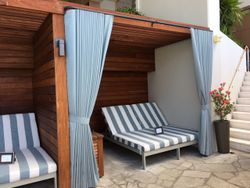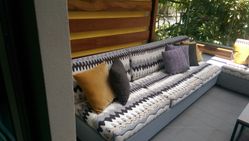Types of Outdoor Fabrics and Treatments

If you're looking to purchase outdoor fabrics, let the experts at Kreative Kama'aina Enterprises assist you with your outdoor projects including outdoor draperies, hardware, cushions and pillows. Their newly renovated showroom is located at 1804 Hart Street in Honolulu, Hawaii.

Before looking for outdoor fabrics, take a moment to assess what you want from your outdoor material. Will this material get wet? Will it be kept out for most of the year or for a few months at a time? What do you plan to use the material for - drapery, cushions, or pillows?
Here are a few typical features you may want to keep in mind:
- Fade resistant
- machine washable, hand wash only, dry clean
- Mold/mildew resistant
- Permeable or breathable
- Stain resistant
- UV blockers
- Waterproof
- Weather resistant
Understanding what type of material you are buying is important. Outdoor fabrics and materials are offered in a wide variety of choices. Keep in mind that not all outdoor material is the same. Below are some common types of material used in outdoor applications.

Acrylic Coated Polyester
This type of material has a tough exterior and a higher quality of resistance to fading, mold and mildew. Acrylic is used to coat the exterior of a woven fabric, enabling it to withstand rubbing, tearing, poking as well as extreme weather like rain and sun. Some manufacturers coat both sides with acrylic to make it extra durable and reversible.
Solution-dyed Acrylic
If sun fading is an issue for your outdoor (or indoor) project, you'll want to look for solution-dyed acrylic material. With solution-dyed acrylic, the fiber is first dyed with acrylic pigments before being turned into yarn and woven into cloth. The advantage is that the color goes all the way through the fibers, making it less susceptible to fading, wear and tear, and in some cases, it can be resistant to bleaching.
Vinyl Coated or Vinyl Coated Synthetic Fiber Mesh
Vinyl (PVC) coating is flexible and durable and when applied to a material it can create something that is strong, flexible and resistant to multiple elements like stains, sunlight, water and mildew. Some find vinyl easier to wipe clean, especially with difficult materials such as sun block.
Acrylic versus Vinyl
Acrylic tends to hold its color better, making it a good choice for areas where sun is strong. It's also breathable compared to vinyl, and may not feel as hot to the touch. Because it is breathable, water may go through acrylic, so vinyl is better at keeping water off. When torn, acrylic usually cannot be repaired as easily as vinyl.
Waterproof vs. Water Repellent vs. Water Resistant
Water proof means that water cannot penetrate the surface.
A water repellent material means that it has been treated so it will not be easily penetrated by water.
Water resistant can be a material that has been treated to repel a certain amount of water but is generally less successful than a water repellent or waterproof material.
Some materials have an external coating applied to it, making it water repellent or water resistant. Keep in mind that many of these coatings wear off over time, especially when washed in a machine or even dry cleaned. Be sure to read the care instructions to understand how best to care for fabric.
For Outdoor drapery, exterior drapery hardware and accessories, contact the experts at www.kreativekamaaina.com or call 808-841-8731.
About the Business
Have a question? Ask the experts!
Send your question

